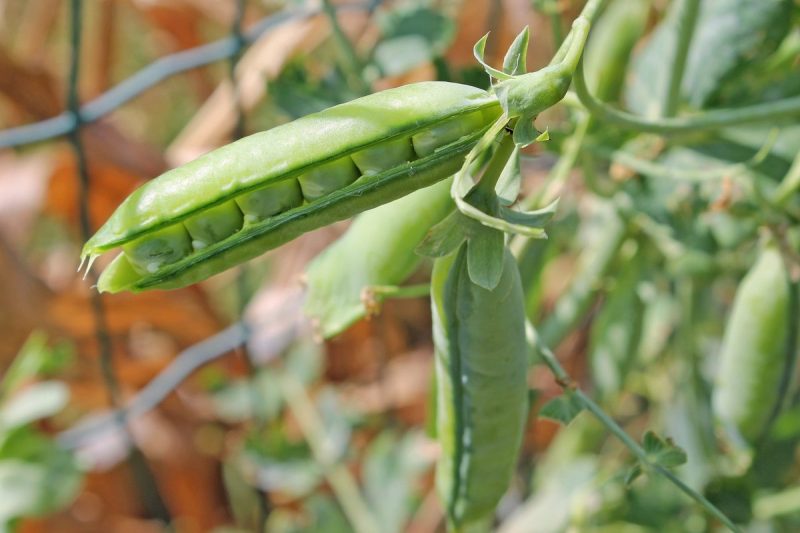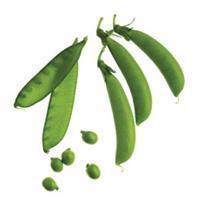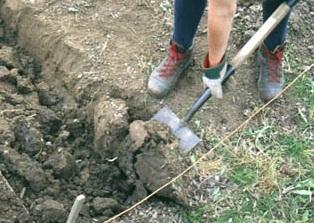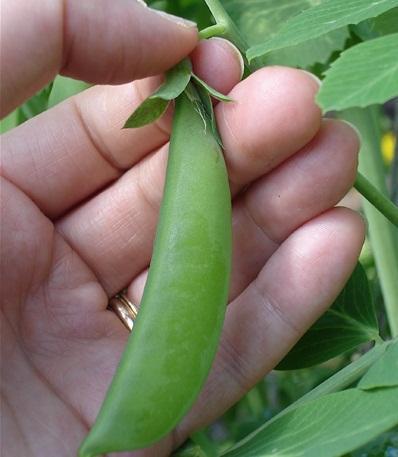Peas, information about crop management

Peas (Pisum sativum) are cultivated for their protein, vitamin, and carbohydrate-rich seeds, which can be consumed in various forms. Because pea plants have the property of fixing atmospheric nitrogen they are used in crop rotation for other vegetable crops. Nitrogen-fixing bacteria known as Rhizobium can be found in the root nodules of legumes such as peas. These bacteria fix nitrogen, which is then taken up by plants and stored in their tissues as plant proteins. The stalks obtained after harvesting are good animal feed because of their high protein content. Peas can also be used as green manure because they enrich the soil with nitrogen.
Peas originate in Asia and Northeast India, and in Europe, the main cultivating countries are England, France, and Italy. Due to the relatively low pedoclimatic conditions, as well as the mechanization of planting and harvesting, it is now cultivated worldwide.
The root system is strong and penetrates the soil up to 40-60 cm deep, but, if the soil allows, it can penetrate up to one meter. The stem is hollow inside and slightly branched. The leaves are pinnately compound, alternately arranged, consisting of 2-3 pairs of leaflets. Flowering takes place 30-50 days after sowing, and on a plant, flowering lasts 10-25 days. The fruit is a pod, straight or arched with a length between 3 and 12 cm. The pea seeds are yellow or green when dry.
Climate and soil requirements
The minimum germination temperature is 1-2 °C for sweet varieties and 4-6 °C for starchy varieties. Peas grow optimally and develop at temperatures of 18-21 °C and yields decrease if the temperature exceeds 26-28 °C. Light requirements are moderate, being a long-day plant. It has high moisture requirements during the seed germination phase and at the beginning of the growing season (until it forms a strong root system). The flowering and pod formation process is negatively influenced by prolonged drought.
Cultivation
Crop rotation
The spring crop should be cultivated after plants that leave the soil clean of weeds such as tomatoes, peppers, cabbage, and cucumbers. After the early pea crop, you can grow winter radishes, autumn cabbage, and autumn cucumbers.
Soil preparation
It starts in the autumn with the removal of the previous crop, followed by basic fertilization after an agrochemical analysis of the soil. Then, basic plowing can be carried out at a depth of 28 – 30 cm. In early spring, the soil should be tilled and leveled. For the early spring crop, the soil must be prepared in autumn by mobilizing it with a disc harrow.
It is important to prepare the soil carefully in the autumn so that sowing takes place as early as possible in the spring. If the soil is not prepared in the autumn, it should be prepared in the spring as soon as possible.
Sowing
Sowing should be done in spring as early as possible, late February or early March when the soil temperature reaches 4-5 °C and tends to increase. The last sowing season is 1 – 2 April. To extend the harvest period, it is recommended to sow simultaneously varieties with different growing seasons. Or, if it is the same variety, it should be sown in 2 – 3, 10 – 15 days apart. For autumn crops, sowing can take place in September. Depending on the germination capacity of the seed, and the chosen cultivation technology, you can use a seed rate of 180 – 300 kg/ha. Sowing should be carried out on well-prepared soil, in rows equidistant at 12.5 cm or in furrows, at a depth of 4 – 5 cm.
Pest and disease control
It is done by applying treatments with approved fungicides or insecticides. To avoid the appearance of diseases or pests resistant to pesticides, it is recommended to alternate products with different active substances.
Weed control
It can be done by applying specific herbicides, respecting the specifications on the label, depending on the product chosen.
Recommended products
-
You can find products on a different store
Change Store -
You can find products on a different store
Change Store -
You can find products on a different store
Change Store -
You can find products on a different store
Change Store -
You can find products on a different store
Change Store -
You can find products on a different store
Change Store -
You can find products on a different store
Change Store -
You can find products on a different store
Change Store -
You can find products on a different store
Change Store -
You can find products on a different store
Change Store -
You can find products on a different store
Change Store -
You can find products on a different store
Change Store -
You can find products on a different store
Change Store -
You can find products on a different store
Change Store -
You can find products on a different store
Change Store -
You can find products on a different store
Change Store -
You can find products on a different store
Change Store -
You can find products on a different store
Change Store -
You can find products on a different store
Change Store -
You can find products on a different store
Change Store -
You can find products on a different store
Change Store -
You can find products on a different store
Change Store -
You can find products on a different store
Change Store -
You can find products on a different store
Change Store
Care works
Because the vegetative growth period is quite short, during this time quite a few works are carried out. The critical times for water supply are: immediately after sowing, during flowering, and when the pods form. If the soil is not sufficiently supplied with water, carry out 1 – 2 irrigations with a rate of 250 – 300 m3/ha.
The peas provide their nitrogen needs through symbiosis with bacteria that fix atmospheric nitrogen, so it does not need additional fertilization. To stimulate plants and to control micronutrient deficiencies, you can apply specific fertilizers.
Recommended products
-
You can find products on a different store
Change Store -
You can find products on a different store
Change Store -
You can find products on a different store
Change Store -
You can find products on a different store
Change Store -
You can find products on a different store
Change Store -
You can find products on a different store
Change Store -
You can find products on a different store
Change Store -
You can find products on a different store
Change Store -
You can find products on a different store
Change Store -
You can find products on a different store
Change Store -
You can find products on a different store
Change Store -
You can find products on a different store
Change Store -
You can find products on a different store
Change Store -
You can find products on a different store
Change Store -
You can find products on a different store
Change Store -
You can find products on a different store
Change Store -
You can find products on a different store
Change Store -
You can find products on a different store
Change Store -
You can find products on a different store
Change Store -
You can find products on a different store
Change Store -
You can find products on a different store
Change Store -
You can find products on a different store
Change Store -
You can find products on a different store
Change Store -
You can find products on a different store
Change Store
Harvesting
Harvesting is staggered according to the variety and time of sowing. Thus, the optimal time of harvest is conditioned by several factors such as the cultivar type, the destination of the production, and the analysis and determination of the sugar and starch content of the seeds.
Normally, the harvest should be done when all the beans in the pods have reached technological maturity. Harvesting can be done in two ways: manual (but it is a difficult operation, indicated for small areas) or mechanized (using special machines).


















































































































































































































































































































































































































































